Seneca Center
Introduction
Text-to-speech Audio
Images
A view of Seneca Glass's strategic location between the Monongahela River and Beechurst Avenue. The Sunnyside neighborhood is located within walking distance. Photo circa 1955, courtesy of the West Virginia and Regional History Center, WVU Libraries.

Glass Blowing at Seneca in the 1960s. Courtesy of the West Virginia and Regional History Center, WVU Libraries.

Glassware from the Seneca Glass Company. Courtesy of the West Virginia and Regional History Center, WVU Libraries.
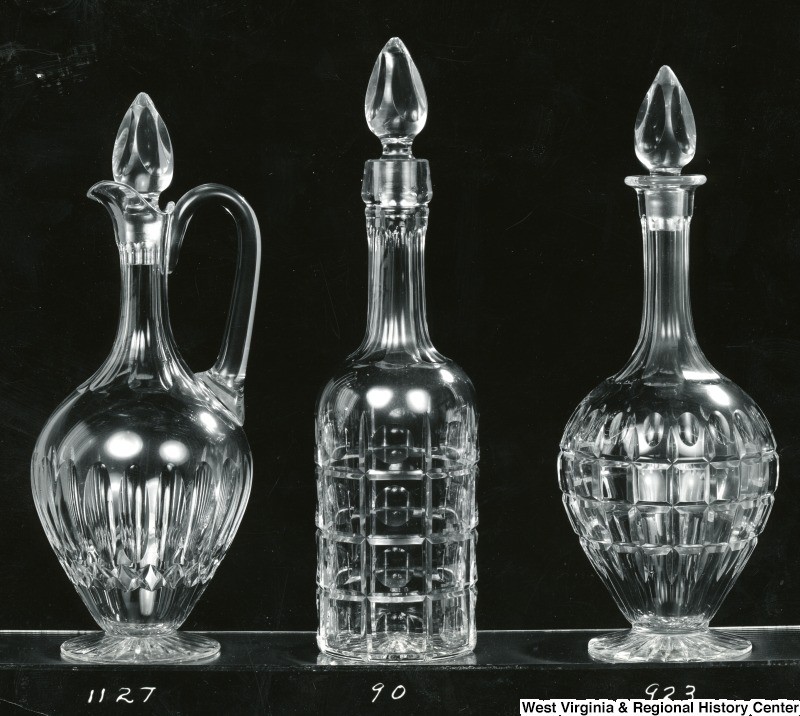
The glass factory has a new life as the Seneca Center, which provides a historic shopping experience and business offices.
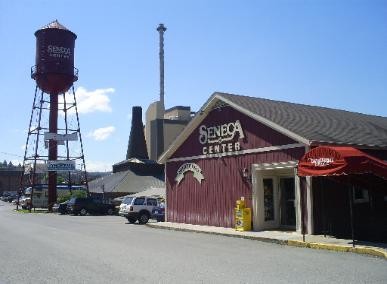
Seneca Glass Factory fire in 1902. Courtesy of the West Virginia and Regional History Center, WVU Libraries.
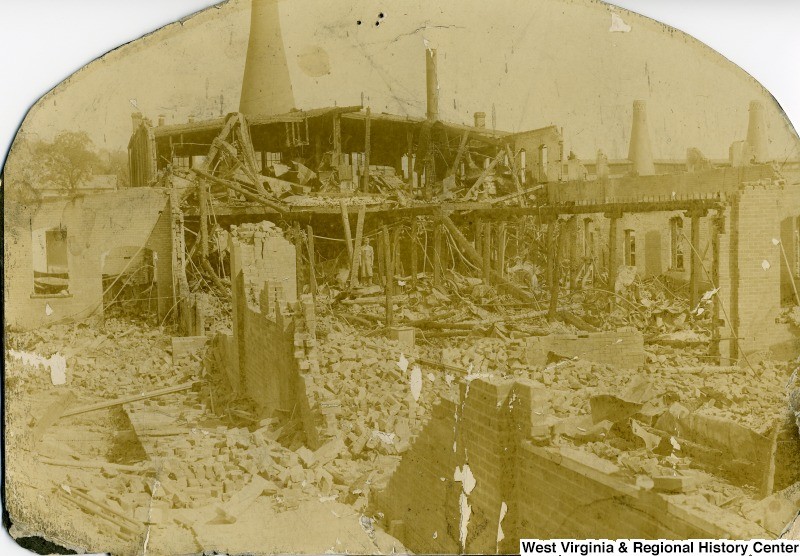
The original Seneca Glass building - 1900
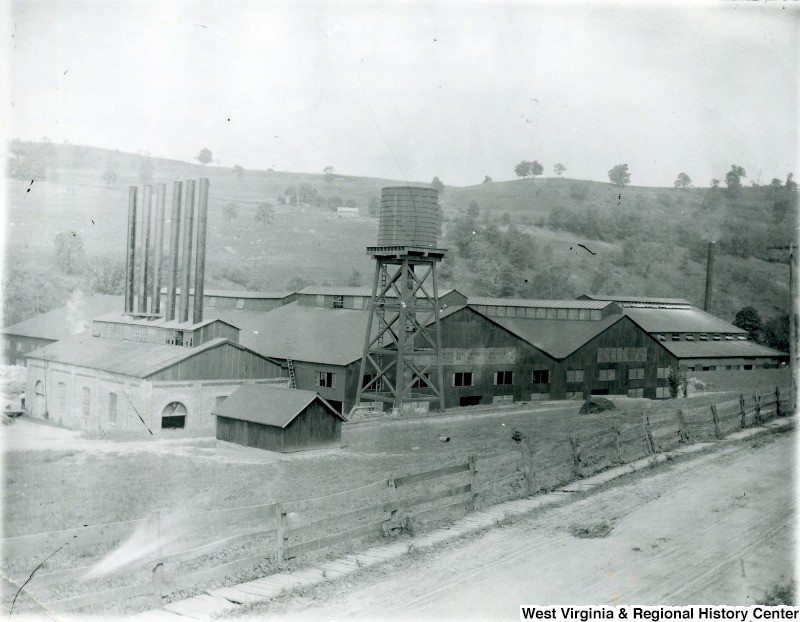
A 1915 view of Morgantown's Sunnyside neighborhood with the Seneca Glass Factory's smokestacks and water tower. Courtesy of the West Virginia and Regional History Center, WVU Libraries.

Seneca Glass Factory in the early twentieth century. The water tower and most of the smokestack still stand today. Courtesy of the West Virginia and Regional History Center, WVU Libraries.

Photograph of a glass blower and mold boy by Lewis Hine, who documented child labor in the early twentieth century. Photo October 1908, courtesy of the Library of Congress.
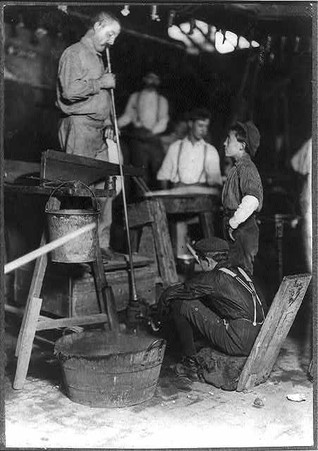
Girls at Seneca Glass wrapping and packing finished glass products. Photo by Lewis Hine, October 1908, courtesy of the Library of Congress.
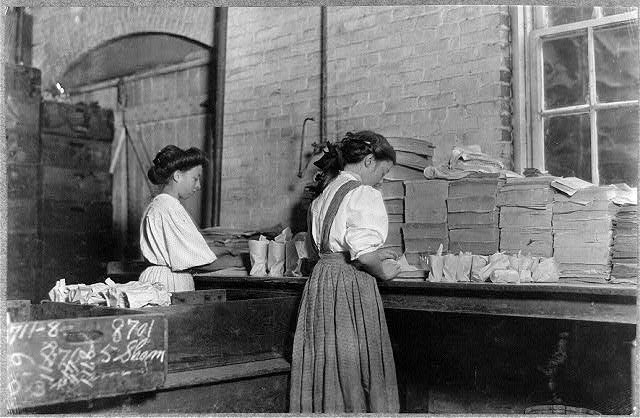
Backstory and Context
Text-to-speech Audio
The creation of the Seneca Glass Factory stems from an 1890s agreement made between the Seneca Glass Company and the Morgantown Building and Investment Company (MBIC). MBIC tempted the Seneca Glass Company to relocate from Fostoria, Ohio, to Morgantown with a rather lucrative legal agreement. The city of Morgantown offered resources such as natural gas and silica, both needed to manufacture glass, and a transportation network consisting of the Monongahela River and the Baltimore and Ohio Railroad. In addition, MBIC made an agreement that stipulated they would pay $20,000 (about half a million dollars in today’s money) to “erect, build and construct…factory buildings” in the “Beechurst Addition” of Morgantown to be used by the Seneca Glass Company.1 The Seneca Glass Factory was constructed in 1896, and the production of glass began in 1897.
The glass industry boom brought European immigrants to Morgantown, who settled in the Sunnyside neighborhood on the other side of Beechurst Avenue. In the early to mid-twentieth century, skilled men arrived from Germany, Belgium, France, and Britain, where glassmaking was a tradition dating to medieval times. Immigrants from Italy, Poland, Slovakia, Russia, and other southern and eastern European countries entered glass factories as unskilled laborers with hopes of making enough money to send back home. Census records indicate that Sunnyside residents spoke a wide variety of European languages in their homes.
Glass factories were divided into two sections: the “hot end” of the factory, where molten glass was shaped and created, and the “cold end” of the factory, where glass pieces were etched, polished, wrapped, and packaged for sale. To make ends meet, the entire family, including children, would work in factories. Men typically worked in the hot end of the factory operating furnaces and blowing glass. Women were usually tasked with completing cold end jobs such as creating detailed etchings on the glass and packing the finished products for shipping. Until child labor laws were established, children’s jobs also tended to conform to the gendered division of labor. Boys assisted the skilled male glassblowers and ran glassware to the cold end of the factory for finishing. Girls assisted with the processes of glazing, etching, and packing.
The first major event to significantly alter the Seneca Glass Factory was a fire in 1902. The fire was discovered in the packing room, before spreading to the rest of the building. Most of the damage was interior, although portions of the brick walls needed rebuilding as well. The Seneca Glass Company used the fire as an opportunity to expand their facilities. In addition to a replacement building, several new areas were added, including expanded cold end facilities. Renowned Morgantown architect, Elmer F. Jacobs, designed these reconstructions and additions. At some point following this redesign and before 1911, the eighty-foot red steel water tower bearing the words “Seneca Glass Co.” was erected and still serves as a defining feature of the site.
To accommodate the demand for glass and American-made products during the Second World War and postwar eras, the Seneca Glass Factory was again expanded in 1947. Several small buildings and the main etching building, which was separate from other buildings, were removed and the plant was put under one roof. At its peak, the factory included an eighty-foot by eighty-foot blowing room with a furnace, lehr (cooling) room, a water tower, fourteen clay ovens, and a thirty-foot chimney. The original chimney displayed careful attention to detail in the geometric brick designs created by local masons. These designs were destroyed by a lightning strike and ensuing wind during a storm in 2015. The chimney has been reconstructed but lacks the original designs.
In the early 1980s, the Seneca Glass Company went bankrupt due to a decline in demand for specialty glass and crystal. The building was deeded to Sanders Floor Covering Incorporated in December 1984. However, this enterprise was short-lived. The current owner of Seneca Glass Factory is Two Trees, Incorporated, who acquired the property in May of 1998. Since then, the Seneca Glass Factory has been renamed to the Seneca Center and adapted into small businesses and offices. The Seneca Center continues to display its original architecture to a remarkable extent. The walls are covered in historical information and artifacts, reminders of the influence the Seneca Glass Factory had on the fabric of Morgantown.
Sources
Boulware, Jenny et al. Tremendous Brick Chimney Which Soars: Site Condition of the Seneca Glass Company Smokestack. Report. History, West Virginia University.
Boulware, Jenny and Andrew Mach. Glass Blowing and Community Building: A History of Morgantown, West Virginia's Sunnyside Neighborhood, 1890-2013. West Virginia History, vol. 9, no. 1. Published 2015.
Core, Earl L. The Monongalia Story: A Bicentennial History. Volume 5. Morgantown, WV. 1974.
Deed of Sale. Volume 51. Morgantown, WV. Monongalia County Clerk's Office.
Fones-Wolf, Ken. Industry, Labor, and Political Economy in Appalachia, 1890-1930s. Champaign, IL. University of Illinois Press, 2007.
Fleming, Dolores A. Seneca Glass Company Building, National Register of Historic Places. January 15th 1985. Accessed July 21st 2020. http://www.wvculture.org/shpo/nr/pdf/monongalia/85003214.pdf.
History, Seneca Center. Accessed July 21st 2020. http://www.senecacenter.com/history/.
"Interesting State News." The Clarksburg Telegram (Clarksburg) July 4th 1902.
Neill, Charles P. Report on the Condition of Woman and Child Wage-Earners in the United States, Volume III: Glass Industry. Washington, D.C.. Government Printing Office, 1911.
Wiley, Samuel T. History of Monongalia County, West Virginia; from its Settlement to the Present Time, with Numerous Biographical & Family Sketches. Kingwood, WV. Preston Publishing Company, 1883.
